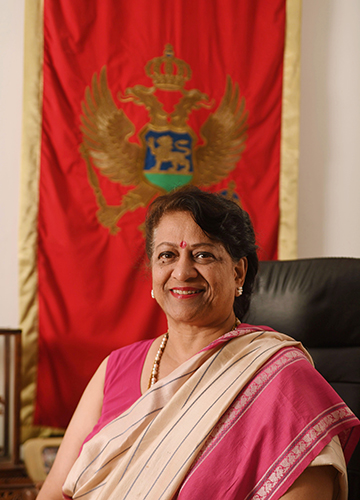From the Swiss Alps and Parisian fashion to Italian cuisine and English architecture, Europe, at large, has been on the bucket list of Indian travellers. Of late, they are exploring less-explored nations such as Croatia and Georgia. Another country that is making an entry into the wish list is Montenegro, which boasts a beautiful coastline and pristine mountains, along with varied architecture and delectable cuisine.
“The tourist footfall from India is going to increase,” says Janice Darbari, Montenegro’s honorary consul general in India. Darbari―whose father was an Indian civil servant―has served as Montenegro’s sole honorary consul general since 2008, two years after India recognised it as an independent sovereign state. Speaking on why an Indian woman is serving as the representative of a Balkan nation, Darbari mentions her extensive work in the region, particularly her role in getting Macedonia recognised by India in the early 1990s.
With a population of fewer than seven lakh, Montenegro offers a wealth of natural beauty. It enjoys a unique climate, shaped by both the Adriatic Sea and the ending of the Dinaric Alps. “It is one of those places where you can travel from a beach to the mountains within an hour,” says Darbari. The Adriatic coastline stretches for 295km, featuring 72km of picturesque beaches, while the north is dominated by stunning mountains, pristine rivers, and scenic lakes like the Skadar Lake and the Black Lake. The diverse landscape makes Montenegro an ideal destination for adventure tourism.
In recent years, many have chosen Montenegro as a wedding destination. Places like Budva, a coastal town on the Adriatic Sea and Kotor, a world heritage site, are quite popular.
Situated on the crossroads between the west and the east, the nation has witnessed a blend of Venetian, Ottoman and socialist influences. It was part of Yugoslavia, along with Croatia, Serbia, Slovenia, Bosnia and Herzegovina, and Macedonia. After the break-up of Yugoslavia, Serbia and Montenegro formed a union in 1992 and called it the Federal Republic of Yugoslavia. In 2006, it held a referendum, and with the majority voting in favour, Montenegro declared its independence.
The imprint of this long and diverse history is visible in the country’s architecture, ranging from Roman mosaics and gray castles to ornate churches and minimalist minarets and mosques to plain socialist-style buildings. The nation ticks all the boxes for those looking for a slice of history or beautiful aesthetics, in general.
The diversity also reflects in the nation’s cuisine, which offers a platter influenced by Slavic, Balkan, and Mediterranean traditions, with everything from risotto to baklava and borek in store. “The food is lovely with leafy greens, peaches, tomatoes, and most importantly cheeses, which we get fresh. So you are talking of a nation bubbling with health and a very prosperous future,” says Darbari.
Speaking on the tourism potential, she says, “We have adventure tourism and places fit for weddings, along with beautiful ports where billionaires come and park their yachts. We have a long tourism season, too, spanning from March all the way to September, and everyone hops across for a dip in the Adriatic Sea, our very own Sangam.”
However, tourism comes at a cost. Last year, there were pictures of Kotor inundated with tourists, posing a risk to its marine environment. Notably, Montenegro’s neighbour Croatia introduced a ‘Respect the city’ plan in 2017 for its UNESCO-listed resort of Dubrovnik, thus capping the number of cruise visitors. “We are very cautious that the ships don’t pollute our water bodies,” Darbari says.
While stressing upon the diversity in experiences the nation has to offer to its tourists, Darbari also highlights that “it is a pocket-friendly destination”.
While attractive to Indians, the absence of direct flights might be a problem for some. “When a person wants to travel, there is a lack of nothing,” says Darbari. “If you have a Schengen visa, you can coordinate your trip to Italy and then Montenegro, for example. And I tell people, it’s very economical. You don’t have to pay extra for your visa to Montenegro.”



